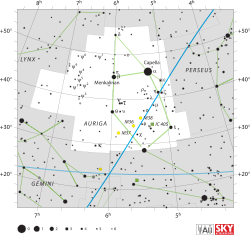Delta Aurigae
 Location of δ Aurigae (circled) | |
| Observation data Epoch J2000 Equinox J2000 | |
|---|---|
| Constellation | Auriga |
| Right ascension | 05h 59m 31.63201s[1] |
| Declination | +54° 17′ 04.7703″[1] |
| Apparent magnitude (V) | 3.715[2] |
| Characteristics | |
| Spectral type | K0 III[3] |
| U−B color index | +0.837[2] |
| B−V color index | +1.017[2] |
| R−I color index | 0.5 |
| Astrometry | |
| Radial velocity (Rv) | +8.2[4] km/s |
| Proper motion (μ) | RA: +81.81[1] mas/yr Dec.: –132.98[1] mas/yr |
| Parallax (π) | 25.88 ± 1.61[1] mas |
| Distance | 126 ± 8 ly (39 ± 2 pc) |
| Details | |
| Radius | 11[5] R☉ |
| Luminosity | 62[5] L☉ |
| Surface gravity (log g) | 2.7[5] cgs |
| Temperature | 4,786[5] K |
| Metallicity [Fe/H] | –0.15[5] dex |
| Rotational velocity (v sin i) | 3.9[5] km/s |
| Other designations | |
Delta Aurigae (δ Aur, δ Aurigae) is the Bayer designation for an astrometric binary[7] star in the constellation Auriga. It is visible to the naked eye with an apparent visual magnitude of 3.715.[2] Based upon its annual parallax shift of 25.88 mas,[1] it is some 126 light-years (39 parsecs) distant from the Earth, give or take an eight light-year margin of error. This star is the namesake for the Delta Aurigids, a meteor shower that occurs between October 6–15.[8] The radiant point for this shower passes several degrees to the south of the star.[9]
The visible component of this system is a giant star with a stellar classification of K0 III.[3] It has 11 times the radius of the Sun and shines with 62 times the Sun's luminosity. This energy is being radiated from the star's outer envelope at an effective temperature of 4,786 K.[5] This heat gives the star the orange-hued glow of a K-type star.[10]
Name
In Indian astronomy, it is known by the Sanskrit name Prajāpati (प्रजापति), "the Lord of Creation".[11][12]
In Chinese, 八穀 (Bā Gǔ), meaning Eight Kinds of Crops, refers to an asterism consisting of δ Aurigae, ξ Aurigae, 26 Camelopardalis, 14 Camelopardalis, 7 Camelopardalis, 9 Aurigae, 11 Camelopardalis and 31 Camelopardalis.[13] Consequently, δ Aurigae itself is known as 八穀一 (Bā Gǔ yī, English: the First Star of Eight Kinds of Crops), refers to the rice.
References
- 1 2 3 4 5 6 van Leeuwen, F. (November 2007), "Validation of the new Hipparcos reduction", Astronomy and Astrophysics, 474 (2): 653–664, arXiv:0708.1752
 , Bibcode:2007A&A...474..653V, doi:10.1051/0004-6361:20078357.
, Bibcode:2007A&A...474..653V, doi:10.1051/0004-6361:20078357. - 1 2 3 4 Oja, T. (August 1986), "UBV photometry of stars whose positions are accurately known. III", Astronomy and Astrophysics Supplement Series, 65 (2): 405–409, Bibcode:1986A&AS...65..405O.
- 1 2 Eggen, O. J. (1962), "Space-velocity vectors for 3483 stars with proper motion and radial velocity", Royal Observatory Bulletin, 51, Bibcode:1962RGOB...51...79E.
- ↑ Wilson, Ralph Elmer (1953), General Catalogue of Stellar Radial Velocities, Washington: Carnegie Institution of Washington, Bibcode:1953GCRV..C......0W.
- 1 2 3 4 5 6 7 Massarotti, Alessandro; et al. (January 2008), "Rotational and Radial Velocities for a Sample of 761 HIPPARCOS Giants and the Role of Binarity", The Astronomical Journal, 135 (1): 209–231, Bibcode:2008AJ....135..209M, doi:10.1088/0004-6256/135/1/209.
- ↑ "del Aur -- Star in double system", SIMBAD Astronomical Database, Centre de Données astronomiques de Strasbourg, retrieved 2012-08-18.
- ↑ Eggleton, P. P.; Tokovinin, A. A. (September 2008), "A catalogue of multiplicity among bright stellar systems", Monthly Notices of the Royal Astronomical Society, 389 (2): 869–879, arXiv:0806.2878
 , Bibcode:2008MNRAS.389..869E, doi:10.1111/j.1365-2966.2008.13596.x.
, Bibcode:2008MNRAS.389..869E, doi:10.1111/j.1365-2966.2008.13596.x. - ↑ Reynolds, Mike D. (2010), Falling Stars: A Guide to Meteors and Meteorites, Haunted Series (2nd ed.), Stackpole Books, p. 42, ISBN 0811736164
- ↑ Lunsford, Robert (2008), Meteors and How to Observe Them, Astronomers' Observing Guides, Springer, p. 86, ISBN 0387094601
- ↑ "The Colour of Stars", Australia Telescope, Outreach and Education, Commonwealth Scientific and Industrial Research Organisation, December 21, 2004, retrieved 2012-01-16
- ↑ "Auriga", by Richard Hinckley Allen in Star Names: Their Lore and Meaning
- ↑ Monier-Williams Sanskrit dictionary: pra-cchana—pra-jalpa
- ↑ (Chinese) 中國星座神話, written by 陳久金. Published by 台灣書房出版有限公司, 2005, ISBN 978-986-7332-25-7.